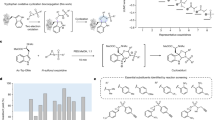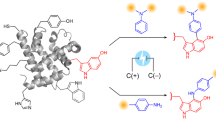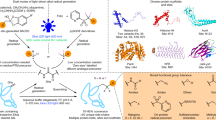Abstract
The chemical modification of proteins is an enabling technology for many scientific fields, including chemical biology, biophysics, bioengineering and materials science. These methods allow the attachment of strategically selected detection probes, polymers, drug molecules and analysis platforms. However, organic reactions that can proceed under conditions mild enough to maintain biomolecular function are limited. Even more rare are chemical strategies that can target a single site, leading to products with uniform properties and optimal function. We present a versatile method for the selective modification of protein N termini that does not require any genetic engineering of the protein target. This reaction is demonstrated for 12 different proteins, including the soluble domain of the human estrogen receptor. The function of this protein was confirmed through the binding of a fluorescent estrogen mimic, and the modified protein was explored as a prototype for the detection of endocrine-disrupting chemicals in water.
This is a preview of subscription content, access via your institution
Access options
Subscribe to this journal
Receive 12 print issues and online access
$259.00 per year
only $21.58 per issue
Buy this article
- Purchase on Springer Link
- Instant access to full article PDF
Prices may be subject to local taxes which are calculated during checkout




Similar content being viewed by others
Accession codes
References
Hermanson, G.T. Bioconjugate Techniques (Academic Press, San Diego, CA, 1996).
Griffin, B.A., Adams, S.R. & Tsien, R.Y. Specific covalent labeling of recombinant protein molecules inside live cells. Science 281, 269–272 (1998).
Zalipsky, S. Functionalized poly(ethylene glycols) for preparation of biologically relevant conjugates. Bioconjug. Chem. 6, 150–165 (1995).
Rao, J., Dragulescu-Andrasi, A. & Yao, H. Fluorescence imaging in vivo: recent advances. Curr. Opin. Biotechnol. 18, 17–25 (2007).
Witus, L.S. & Francis, M.B. Using synthetically modified proteins to make new materials. Acc. Chem. Res. 44, 774–783 (2011).
Szobota, S. et al. Remote control of neuronal activity with a light-gated glutamate receptor. Neuron 54, 535–545 (2007).
Cornish, V.W., Hahn, K.M. & Schultz, P.G. Site-specific protein modification using a ketone handle. J. Am. Chem. Soc. 118, 8150–8151 (1996).
Deiters, A. et al. Adding amino acids with novel reactivity to the genetic code of Saccharomyces cerevisiae. J. Am. Chem. Soc. 125, 11782–11783 (2003).
van Hest, J.C.M., Kiick, K.L. & Tirrell, D.A. Efficient incorporation of unsaturated methionine analogues into proteins in vivo. J. Am. Chem. Soc. 122, 1282–1288 (2000).
Dawson, P.E., Muir, T., Clark-Lewis, I. & Kent, S. Synthesis of proteins by native chemical ligation. Science 266, 776–779 (1994).
Muir, T.W. Semisynthesis of proteins by expressed protein ligation. Annu. Rev. Biochem. 72, 249–289 (2003).
Wu, P. et al. Site-specific chemical modification of recombinant proteins produced in mammalian cells by using the genetically encoded aldehyde tag. Proc. Natl. Acad. Sci. USA 106, 3000–3005 (2009).
Uttamapinant, C. et al. A fluorophore ligase for site-specific protein labeling inside living cells. Proc. Natl. Acad. Sci. USA 107, 10914–10919 (2010).
Baker, D.P. et al. N-terminally PEGylated human interferon-β-1a with improved pharmacokinetic properties and in vivo efficacy in a melanoma angiogenesis model. Bioconjug. Chem. 17, 179–188 (2006).
Singudas, R., Adusumalli, S.R., Joshi, P.N. & Rai, V. A phthalimidation protocol that follows protein defined parameters. Chem. Commun. (Camb.) 51, 473–476 (2015).
Chan, A.O.Y. et al. Modification of N-terminal α-amino groups of peptides and proteins using ketenes. J. Am. Chem. Soc. 134, 2589–2598 (2012).
Tam, J.P., Yu, Q. & Miao, Z. Orthogonal ligation strategies for peptide and protein. Biopolymers 51, 311–332 (1999).
Geoghegan, K.F. & Stroh, J.G. Site-directed conjugation of nonpeptide groups to peptides and proteins via periodate oxidation of a 2-amino alcohol. Application to modification at N-terminal serine. Bioconjug. Chem. 3, 138–146 (1992).
Ning, X. et al. Protein modification by strain-promoted alkyne-nitrone cycloaddition. Angew. Chem. Int. Ed. Engl. 49, 3065–3068 (2010).
Li, X., Zhang, L., Hall, S.E. & Tam, J.P. A new ligation method for N-terminal tryptophan-containing peptides using the Pictet-Spengler reaction. Tetrahedr. Lett. 41, 4069–4073 (2000).
Gilmore, J.M., Scheck, R.A., Esser-Kahn, A.P., Joshi, N.S. & Francis, M.B. N-terminal protein modification through a biomimetic transamination reaction. Angew. Chem. Int. Ed. Engl. 45, 5307–5311 (2006).
Witus, L.S. et al. Site-specific protein transamination using N-methylpyridinium-4-carboxaldehyde. J. Am. Chem. Soc. 135, 17223–17229 (2013).
Dixon, H.B.F. & Fields, R. Specific modification of NH2-terminal residues by transamination. Methods Enzymol. 25, 409–419 (1972).
Dixon, H.B.F. N-terminal modification of proteins—a review. J. Protein Chem. 3, 99–108 (1984).
Obermeyer, A.C., Jarman, J.B. & Francis, M.B. N-terminal modification of proteins with o-aminophenols. J. Am. Chem. Soc. 136, 9572–9579 (2014).
Baldwin, J.E. Rules for ring closure. J. Chem. Soc. Chem. Commun. 734–736 (1976).
San George, R.C. & Hoberman, H.D. Reaction of acetaldehyde with hemoglobin. J. Biol. Chem. 261, 6811–6821 (1986).
Metz, B. et al. Identification of formaldehyde-induced modifications in proteins: reactions with model peptides. J. Biol. Chem. 279, 6235–6243 (2004).
Fraenkel-Conrat, H. & Olcott, H.S. Reaction of formaldehyde with proteins: VI. Cross-linking of amino groups with phenol, imidazole, or indole groups. J. Biol. Chem. 174, 827–843 (1948).
Join, B. et al. Selective iron-catalyzed oxidation of benzylic and allylic alcohols. Adv. Synth. Catal. 353, 3023–3030 (2011).
Storr, T. et al. Ru(iii) complexes of Edta and Dtpa polyaminocarboxylate analogues and their use as nitric oxide scavengers. Eur. J. Inorg. Chem. 2005, 2685–2697 (2005).
Gaertner, H.F. & Offord, R.E. Site-specific attachment of functionalized poly(ethylene glycol) to the amino terminus of proteins. Bioconjug. Chem. 7, 38–44 (1996).
Peter, W. et al. Interchain cysteine bridges control entry of progesterone to the central cavity of the uteroglobin dimer. Protein Eng. 5, 351–359 (1992).
Glazer, A.N. Specific chemical modification of proteins. Annu. Rev. Biochem. 39, 101–130 (1970).
Anderson, P.J. & Perham, R.N. The reactivity of thiol groups and the subunit structure of aldolase. Biochem. J. 117, 291–298 (1970).
Joo, C., Balci, H., Ishitsuka, Y., Buranachai, C. & Ha, T. Advances in single-molecule fluorescence methods for molecular biology. Annu. Rev. Biochem. 77, 51–76 (2008).
Witus, L.S. et al. Identification of highly reactive sequences for PLP-mediated bioconjugation using a combinatorial peptide library. J. Am. Chem. Soc. 132, 16812–16817 (2010).
Wiita, A.P., Hsu, G.W., Lu, C.M., Esensten, J.H. & Wells, J.A. Circulating proteolytic signatures of chemotherapy-induced cell death in humans discovered by N-terminal labeling. Proc. Natl. Acad. Sci. USA 111, 7594–7599 (2014).
Diamanti-Kandarakis, E. et al. Endocrine-disrupting chemicals: an endocrine society scientific statement. Endocr. Rev. 30, 293–342 (2009).
Ternes, T.A. et al. Ozonation: a tool for removal of pharmaceuticals, contrast media and musk fragrances from wastewater? Water Res. 37, 1976–1982 (2003).
Blair, R.M. et al. The estrogen receptor relative binding affinities of 188 natural and xenochemicals: structural diversity of ligands. Toxicol. Sci. 54, 138–153 (2000).
Gangloff, M. et al. Crystal structure of a mutant hERα ligand-binding domain reveals key structural features for the mechanism of partial agonism. J. Biol. Chem. 276, 15059–15065 (2001).
Gryder, B.E. et al. Histone deacetylase inhibitors equipped with estrogen receptor modulation activity. J. Med. Chem. 56, 5782–5796 (2013).
Himo, F. et al. Copper(i)-catalyzed synthesis of azoles. DFT study predicts unprecedented reactivity and intermediates. J. Am. Chem. Soc. 127, 210–216 (2004).
Cecconi, C., Shank, E.A., Bustamante, C. & Marqusee, S. Direct observation of the three-state folding of a single protein molecule. Science 309, 2057–2060 (2005).
Banerjee, D., Liu, A.P., Voss, N.R., Schmid, S.L. & Finn, M.G. Multivalent display and receptor-mediated endocytosis of transferrin on virus-like particles. ChemBioChem 11, 1273–1279 (2010).
Stephanopoulos, N., Tong, G.J., Hsiao, S.C. & Francis, M.B. Dual-surface modified virus capsids for targeted delivery of photodynamic agents to cancer cells. ACS Nano 4, 6014–6020 (2010).
Laemmli, U.K. Cleavage of structural proteins during the assembly of the head of bacteriophage T4. Nature 227, 680–685 (1970).
Wang, H. et al. Self-assembled nanospheres as a novel delivery system for taxol: a molecular hydrogel with nanosphere morphology. Chem. Commun. (Camb.) 47, 4439–4441 (2011).
Van Gompel, J. & Schuster, G.B. Chemiluminescence of organic peroxides: intramolecular electron-exchange luminescence from a secondary perester. J. Org. Chem. 52, 1465–1468 (1987).
Acknowledgements
The development of this reaction was supported by the Energy Biosciences Institute at the University of California–Berkeley. The application of the reaction to the human estrogen receptor was supported by the US National Science Foundation (CHE-1059083 and CHE-1413666). J.I.M. was supported by the Berkeley Chemical Biology Graduate Program (National Research Service Award Training grant 1 T32 GMO66698). H.K.M. was supported by the Villum Kann Rasmussens Foundation as well as the Laboratory Directed Research and Development Program at Lawrence Berkeley National Labs. We would like to acknowledge M. Dedeo for the tobacco mosaic virus coat protein, L. Witus for the GFP and A. Obermeyer for X-ADSWAG peptides (all at the University of California-Berkeley).
Author information
Authors and Affiliations
Contributions
J.I.M. and M.B.F. conceived the project. J.I.M. developed the bioconjugation reaction and synthesized the 2PCA derivatives. H.K.M. performed the protein immobilization and binding experiments. H.K.M. and T.M. performed the expression and purification of uteroglobin and the human estrogen receptor. J.I.M. and M.B.F. wrote the manuscript. All of the authors reviewed and contributed to the manuscript.
Corresponding author
Ethics declarations
Competing interests
The authors declare no competing financial interests.
Supplementary information
Supplementary Text and Figures
Supplementary Results, Supplementary Figures 1–13 and Supplementary Note. (PDF 1934 kb)
Rights and permissions
About this article
Cite this article
MacDonald, J., Munch, H., Moore, T. et al. One-step site-specific modification of native proteins with 2-pyridinecarboxyaldehydes. Nat Chem Biol 11, 326–331 (2015). https://doi.org/10.1038/nchembio.1792
Received:
Accepted:
Published:
Issue Date:
DOI: https://doi.org/10.1038/nchembio.1792
This article is cited by
-
A disintegrin derivative as a case study for PHIP labeling of disulfide bridged biomolecules
Scientific Reports (2022)
-
Photoredox C–H functionalization leads the site-selective phenylalanine bioconjugation
Scientific Reports (2022)
-
Traceless cysteine-linchpin enables precision engineering of lysine in native proteins
Nature Communications (2022)
-
Bioorthogonal chemistry
Nature Reviews Methods Primers (2021)
-
Modification of N-terminal α-amine of proteins via biomimetic ortho-quinone-mediated oxidation
Nature Communications (2021)



